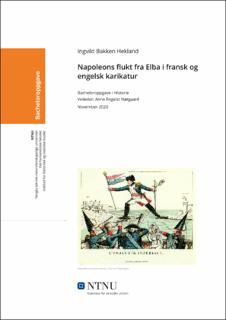| dc.contributor.advisor | Nørgaard, Anne Engelst | |
| dc.contributor.author | Hekland, Ingvild Bakken | |
| dc.date.accessioned | 2021-09-13T16:05:58Z | |
| dc.date.available | 2021-09-13T16:05:58Z | |
| dc.date.issued | 2020 | |
| dc.identifier | no.ntnu:inspera:67960342:30865263 | |
| dc.identifier.uri | https://hdl.handle.net/11250/2775648 | |
| dc.description.abstract | Denne oppgaven tar utgangspunkt i Erwin Panofskys metode for ikonografisk analyse og forsøker å besvare spørsmålet «hva er det egentlige budskapet i napoleonskarikaturene L’enjambée impériale og Escape of Buonaparte from Elba, samt på hvilke måter skiller den franske og den engelske karikaturen seg fra hverandre?». Begge karikaturene er fra 1815 og ble publisert under det som i senere tid er blitt kalt for 100 dagerskrigen. De handler begge om Napoleon Bonaparte sin flukt fra sitt eksil på øya Elba og hans forsøk på å ta tilbake makten i Frankrike. Målet med å også anvende en metode som gir en komparativ analyse, der en engelsk napoleonskarikatur sammenlignes med en fransk, er for å se på hvordan disse to nasjonalitetenes karikaturer skiller seg fra hverandre. Ikke minst hva som kan være grunnen til hvorfor de britiske i senere tid er mer synlige, samt hva slags syn på Napoleon i 100 dagerskrigen man kan lese av dem.
Først forklares forholdet mellom Frankrike og Storbritannia fra omtrent starten av den franske revolusjonen, samt karikaturenes historiske kontekst i form av 100 dagerskrigen og spesielt forholdene innad Frankrike angående Napoleon sin tilbakekomst. Deretter anvendes kunsthistoriker Erwin Panofsky sin ikonografiske analyse på karikaturene hver for seg, før resultatet av disse to analysene settes inn i karikaturkonteksten i disse to landene og sammenlignes med hverandre. | |
| dc.description.abstract | This thesis are based on Erwin Panofskys method for iconographic analysis and seek to answer the question of «what is the message in the napoleon caricatures L’enjambée impériale and Escape of Buonaparte from Elba, additionally in which ways the French and English caricatures are different from each other?». Both caricatures are from the year of 1815 and was made public in a period later called The 100 Days War. Both portraits the escape of Napoleon Bonaparte from his exile on the island Elba and his attempt to take back his position in France. The reason behind using a comparative analysis where you compare an english caricature with a french one, is because you want to look on how these two nationalities caricatures vary from each other. Not at least why the English ones seems to be more visible in later times. What kind of perspective on Napoleon within the 100 days war, and what we are able to learn from them is also essential.
First the relationship between France and Great Britain from about the french revolution will be explained, then the historic context of the caricatures in The 100 Days War and especially the conditions within France when it comes to Napoleons return. Afterwards the iconographic analysis of art historian Erwin Panofsky would be used on each of the caricatures separately, before placing the result of both analysis in the caricature context of both countries and compare them with each other. | |
| dc.language | | |
| dc.publisher | NTNU | |
| dc.title | Napoleons flukt fra Elba i fransk og engelsk karikatur | |
| dc.type | Bachelor thesis | |
